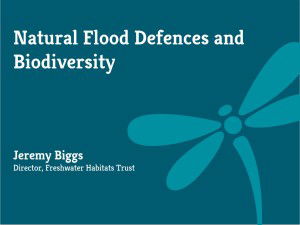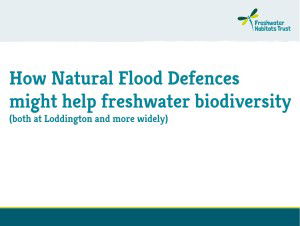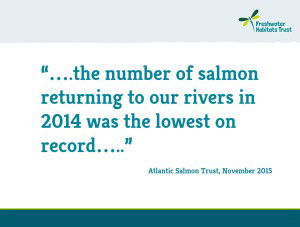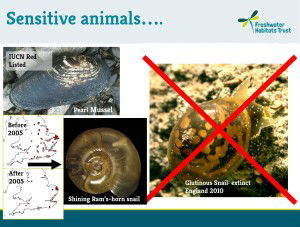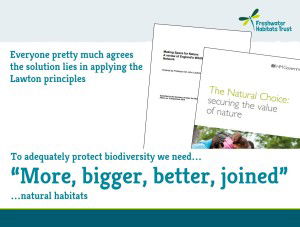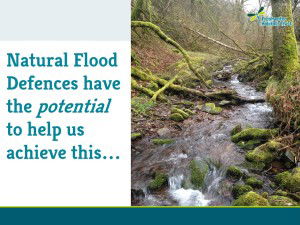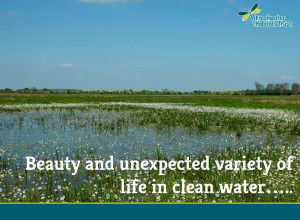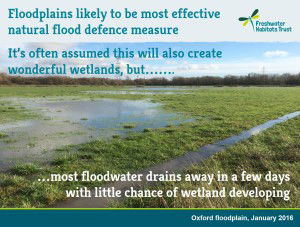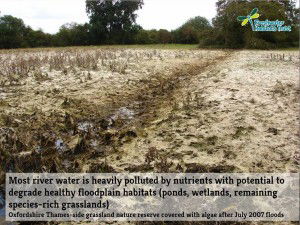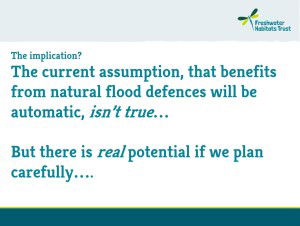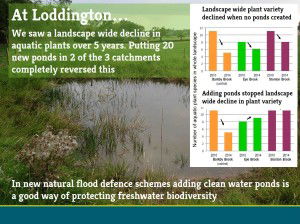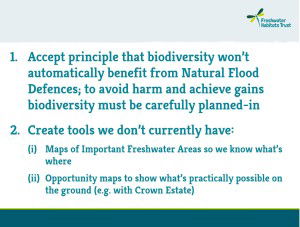Natural Flood Defences and Biodiversity
31st March 2016
Natural flood defences have had a rush of interest in recent months, and many claim beavers, leaky dams and tree planting to be a panacea for devastating floods. But do they bring benefits for freshwater wildlife?
Freshwater Habitats Trust Director Dr Jeremy Biggs was one of the speakers at a meeting of the All Party Parliamentary Group for Biodiversity on 1st March 2016 discussing the policy and practicality of natural flood defences. Jeremy brought biodiversity to the table, and questioned the assumption that wildlife would automatically benefit.
In his talk, Jeremy set out the principles of what we would need to do to ensure that freshwater biodiversity really benefited from the drive for natural flood defences. The slides and text below are the talk he gave to the APPG.
Jeremy Biggs: “Hello Everyone – and thanks for this opportunity to talk about freshwater biodiversity and Natural Flood Defences because….
….there’s no doubt that life in freshwater needs help.
Species like salmon and eel are in long-term decline as are characteristic river waterbirds like dipper, grey wagtail, common sandpiper, kingfisher….”
“….Aquatic plants like Long-stalked Pondweed, bladderworts, Water-violet, many stoneworts – really anything sensitive to nutrients – are declining generally….”
“….Sensitive animals, from freshwater snails and bivalves (pearl mussel, glutinous snail, shining Ram’s-horn) to Atlantic stream crayfish and water voles are hanging on in fewer locations….”
“….Pretty much everyone in science and conservation agrees with the principles of the government commissioned 2010 Lawton report which said that to adequately protect biodiversity in the UK we need “more, bigger, better and joined” habitats….”
“….Natural flood management has the potential to help us achieve this – with extensive planting of new broadleaved woodlands to protect headwater streams, rewetting moors, and the restoration of the beautiful and unexpected variety of life to be seen in the cleanest, unpolluted, most natural freshwaters….”
“….But the evidence from the last 30 years restoration research suggests we’ll get a fraction of the possible freshwater biodiversity gains if we don’t plan them in at the start: the current assumption, that benefits will follow automatically from the application of natural flood management methods, isn’t true….”
“….A single example: we know that storing water on floodplains is likely to be the most effective natural flood defence measure. There is a widespread assumption that will also create wonderful wetlands. But:
(i) most floodwater water will usually be stored on land just for a few days, then drain off, without potential for new wetlands or freshwater habitats to develop.
(ii) almost all river water in England is heavily polluted by nutrients – and putting polluted water onto floodplains is not a natural process. That water has the potential to degrade healthy floodplain habitats: ponds, wetlands, and remaining species-rich grasslands, like this Thames-side meadow after the 2007 flood.
“….The implication is that we need to be realistic about biodiversity benefits, if we want to get them….”
“…We know from our work on the Water Friendly Farming project, with Game & Wildlife Conservation Trust at Loddington, Leicestershire, that creating new clean-water ponds actually halted and reversed a landscape-wide decline in the diversity of wetland plants over the previous 5 years. So, for example, as part of Natural Flood Defences, including new clean-water ponds in woodland planting schemes would be a way of helping freshwater wildlife….”
“….Another example is the catchment of the River Ock where a scheme to prevent flooding of Abingdon is currently being designed. Using Natural Flood Defence principles, there are opportunities here to add woodland to slow flows and store water on the floodplains.
Unfortunately, just planting trees will bring limited benefits for freshwater biodiversity….”
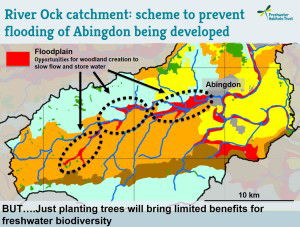
“….But if we add some simple target measures (adding small pools, wetlands, backwaters) it could make a huge difference. This is one of two areas where we’re trialing the concept of Important Freshwater Areas (essentially mapping biodiversity hotspots) with the Catchment-based Approach project.
So if we match Natural Flood Defence opportunities to the freshwater biodiversity hotspots, we can see that one overlaps around Abingdon….”
“….This is an area that has one of only 3 UK sites for the exceptionally rare iridescent blue Pondweed Leafhopper, plus Water-violet, Water Vole and a host of other species – none incidentally in protected areas.
There is enormous potential to benefit these species by incorporating new habitats that will deliver the Lawton principles of ‘more, bigger, better and joined’….”
“…..So, to get the best for freshwater biodiversity from Natural Flood Defences we need to do four things, shown in the next slides….”
“….Thank-you.”
What next?
- Read more about our Water Friendly Farming research.
- Find out more about our thoughts on floods and land management: the myths and reality.
- Get involved in our search for clean water for wildlife.
- Learn more about the Freshwater Habitats Trust.
- Support our work to protect freshwater wildlife for everyone to enjoy.

